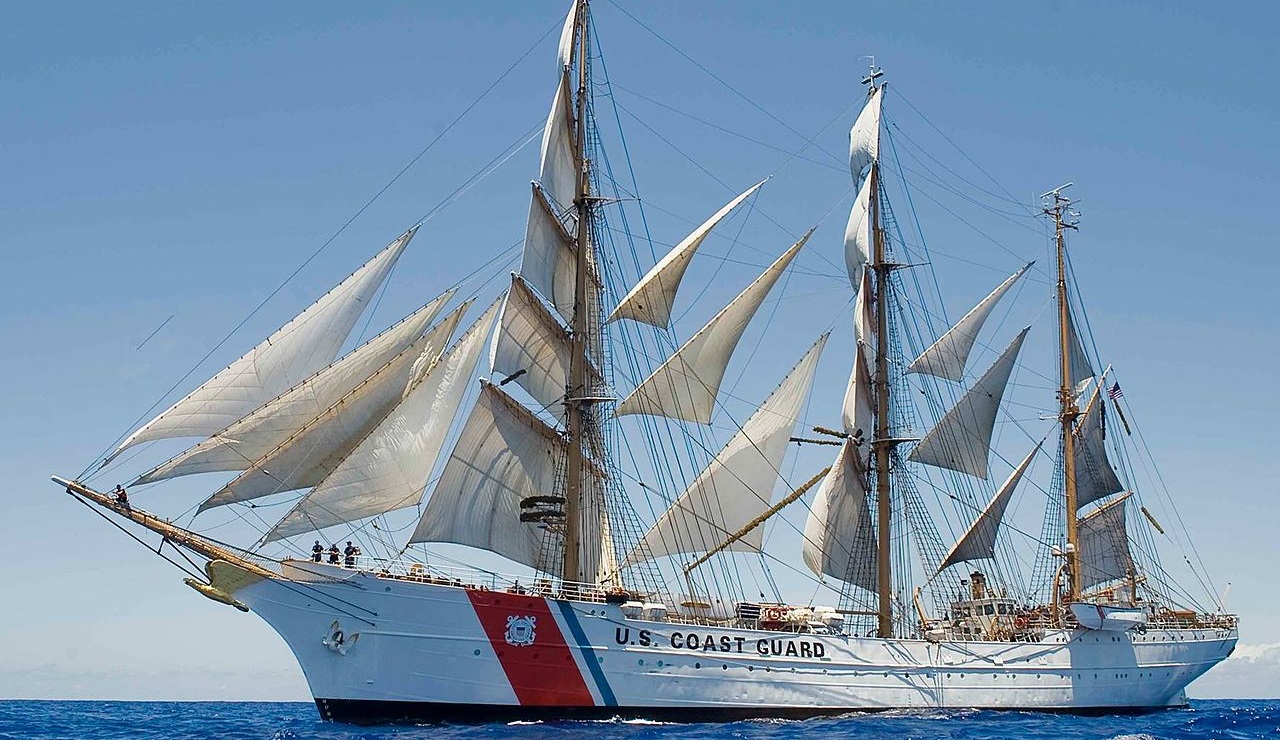The United States Navy’s USS Constitution is currently the world’s oldest commissioned ship still afloat. Launched in 1797, she is one of the six original frigates authorized for construction by the Naval Act of 1794, and the third constructed. It was during her actions in the War of 1812 – when she successfully defeated five British warships whose cannonballs seemed to bounce off her – that she earned the nickname “Old Ironsides.” USS Constitution has been repeatedly saved for scrapping and has been a museum ship since 1907, and she remains a fully commissioned Navy ship – yet, the three-masted wooden-hull heavy frigate isn’t the only sailing ship still in service with the United States military.
Each year, throughout the spring, summer, and fall, cadets and officer candidates of the United States Coast Guard regularly train aboard the USCGC Eagle (WIX-327), a 295-foot (90 meters) barque. Even in the age of state-of-the-art ships and aircraft, the sailing ship is used to provide conditions and situations that can’t be replicated in either a classroom or aboard today’s modern vessels. The cadets who serve on the sailing ship are meant to find themselves completely out of the element – dependent on wind, waves, and currents, and must quickly learn how those forces of nature affect a vessel. The training is further meant to help in ship-handling, decision making, and the meeting of unexpected challenges; while cadets learn the value of teamwork. To maneuver Eagle under sail, the crew must handle more than 22,000 square feet of sail and five miles of rigging.
In addition to its role as a training cutter for future officers of the Coast Guard, the ship also has been used in a public relations role and has made numerous foreign port visits as a goodwill ambassador. She has hosted multiple U.S. Presidents, including Truman, Kennedy, and Nixon.
All that is more notable as Eagle was actually built by Nazi Germany and was previously used to train German sailors in sail techniques. She was one of three sail-training ships built at the Blohm+Voss Shipyard in Hamburg. Commissioned in 1935, she was operated by the Kriegsmarine in the late 1930s and was first commissioned as SSS Horst Wessel. At the close of the Second World War, the ship was taken as a war reparation by the United States and re-commissioned as the U.S. Coast Guard Cutter Eagle. Her permanent homeport is New London, Connecticut.
The Horst Wessel
While actually the second of the Gorch Fock-class of sail training ships, Horst Wessel was an improvement of the original design. She was larger in dimension and her spars were made of steel. Named in tribute to SA leader Horst Wessel, an early supporter of Adolf Hitler and a notorious martyr of the Nazi cause, her launch was a major propaganda event for Nazi Germany.
Adolf Hitler was present at the ceremony, while Deputy Führer of the Nazi Party Rudolf Hess gave a speech about the sacrifices of the early party member. Wessel’s mother even christened the vessel.
Even in the Nazi era, Horst Wessel was an unusual name for the ship, as most vessels honored German naval heroes of ages past. Yet, during the Nazi era, Wessel’s life was glorified in memorials, books, and films. In fact, however, the truth is that Wessel was actually little more than a street thug, who was killed by members of the German Communist Party. The Nazis needed a martyr and found one in Wessel.
The 22-year-old’s greatest legacy is that he wrote a march for the fledging Nazi Party. It became known as “Horst-Wessel-Lied” (Horst Wessel Song) after his death and served as a co-national anthem of Germany.
The vessel’s actual service with the German Navy as a training ship was short-lived, but in 1938 she undertook a four-month voyage to the Caribbean, visiting St. Thomas and Venezuela. Decommissioned with the outbreak of the Second World War, she was later used as a training vessel for the marine branch of the Hitler Youth.
In U.S. Service
The U.S. “won” the vessel in drawing lots to determine which nations would receive Germany’s four sailing vessels as war reparations. Horst Wessel was won by the American delegation and soon after the ship was requested by the United States Coast Guard Academy’s Superintendent, and subsequently renamed Eagle – which was fitting given the ship’s original large eagle figurehead.
The transfer itself was something of a legend – and in June 1946 an American crew, assisted by the original German captain and his remaining sailors, steered the newly rechristened Eagle from Bremerhaven, through an Atlantic hurricane, to New York.
She is actually the seventh U.S. Coast Guard cutter to bear the name in a proud line dating back to 1792. While her origin may have been with the insidious Nazi regime, Eagle has helped train Coast Guard officers for more than 75 years.
A Senior Editor for 1945, Peter Suciu is a Michigan-based writer who has contributed to more than four dozen magazines, newspapers and websites. He regularly writes about military hardware, firearms history, cybersecurity and international affairs. Peter is also a Contributing Writer for Forbes. You can follow him on Twitter: @PeterSuciu.

